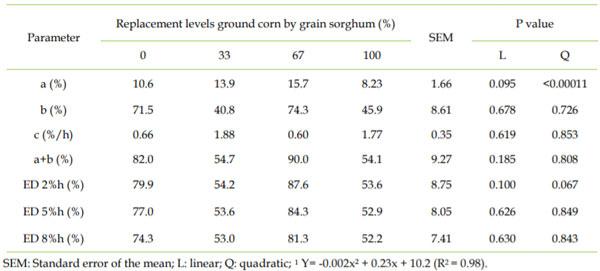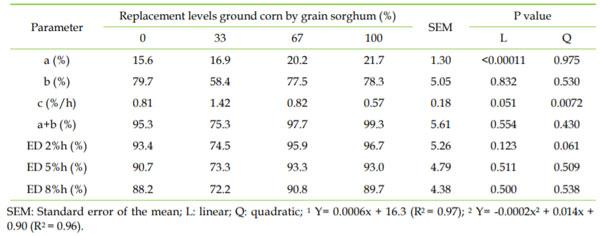INTRODUCTION
Sorghum (Sorghum bicolor (L.) Moench) is a tropical forage species widely used in ruminant nutrition. Sorghum is considered the best option in arid and semi-arid regions worldwide. Sorghum is a typical plant of hot climates due to its xerophilic characteristics, low soil fertility requirements, high tolerance/resistance to water stress and salinity (HASSAN et al., 2018).
Sorghum grain has been used as an energy source in ruminant diet formulation and is considered a great alternative to corn. Ground corn replacement by sorghum grain as an energy source is considered appropriate since both sources contain the main non-fibrous carbohydrate (NFC) which is made up of the starch (GOMÉZ et al., 2016).
However, some sorghum cultivars have tannins which are polyphenolic compounds found in a wide variety of plant species commonly grazed by ruminants (RIVERA-MÉNDEZ et al., 2017). These compounds may provide beneficial effects to ruminal metabolism which are related to their ability to form insoluble complexes with molecules and therefore, enable better nutrient synchronism in the rumen (NAUMANN et al., 2017). Nevertheless, depending on their concentration in the diet, tannins may cause adverse effects to antimicrobial activity which result in decreased fiber digestion (VASTA et al., 2019).
The presence of phenolic compounds in ruminant diets can affect rumen metabolism, influencing the availability of nutrients for microorganisms and disturbing the rumen microbial ecosystem. In order to assess the implications of tannin on the degradation of nutrients from sorghum grain in diets with proportions of NFC sources, it becomes relevant to study the formulations of diets for ruminants in tropical regions.
Therefore, the objective of the present study was to evaluate the effect of ground corn replacement by high-tannin sorghum grain in the diet of steers on ruminal degradation of dry matter and on the fibrous fraction of sorghum grain.
MATERIALS AND METHODS
Animals, experimental design and diets
The experiment was carried out in the Laboratory of Education and Research in Dairy Cattle at the Federal University of Paraiba (UFPB), Campus II, Areia, Paraíba, Brazil (6°57'S, 35°41'W). All animal care and handling procedures were approved by the Animal Care and Use Committee, Federal University of Paraiba, according to protocol No. 014/2015.
The experiment lasted 60 days and was divided into 4 periods of 15 days each, 10 days for animals’ adaptation and 5 days for sample collection. Four castrated and rumen-fistulated crossbred Zebu cattle with an initial mean body weight of 519 ± 31 kg were used in this study. These animals were divided into groups using a 4´4 Latin square experimental design. Animals received four different diets in which increasing levels of ground corn were replaced with high-tannin sorghum grain in the proportions of 0%, 33%, 67% and 100% in the concentrate (Table 1).
Table 1 - Proportion of the ingredients of steer diets based on natural matter, tannin concentration, nutrient con-tents of grain sorghum and diets with levels of replacement of ground corn by high-tannin grain sorghum.
Diets were formulated and balanced according to the nutrient requirements of steers with 500 kg of body weight (NRC, 1996). Diet formulation included the following ingredients: elephant grass silage (Pennisetum purpureum) as a forage source and ground corn and/or high-tannin sorghum grain, soybean meal, wheat bran, urea and mineral mixture® as the concentrate with a roughage:concentrate ratio of 60:40. Diets were given to cattle as a total mixed ration allowing approximately 10% of leftovers and were divided into two portions of the same weight which were offered to these animals at 7:00am and 4:00pm. Animals were kept in individual 3´3 m covered stalls with concrete floors, feeders and individual water fountains and ad libitum access to water.
In order to estimate the diet composition, high-tannin sorghum grain, ingredients and elephant grass silage were sampled during the collection period. Silage samples were placed in a forced-ventilation oven at 55 ºC for 72 h for drying. Sorghum grain samples and ingredients were ground to produce particles of 1 mm and then stored for subsequent analyses.
Experimental procedures
The hybrid A9904 sorghum seeds were planted in an area located at the Laboratory of Education and Research in Dairy Cattle, Department of Animal Sciences, Federal University of Paraiba (UFPB), Campus II, Areia, Paraíba, Brazil. Panicle cutting was performed with grains in the dry state (87% DM), with the aid of a pair of pruning shears. After being harvested, panicles were sun-dried and then coupled to a grain disintegrator for grain sorghum grinding in order to obtain particles of 6 mm. These samples was packed in 30 kg raffia bags over pallets in an airy and moisture-free area.
Dry matter degradability (DMD) and neutral detergent fiber (DNDF) were measured by in situ incubation of sorghum grain samples which were processed in a knife mill (2 mm). These samples were stored in 12 cm ´ 21 cm non-woven textile bags (NWT - 100 g/m²) with a ratio of 20 mg per DM/cm2 and were incubated in the 4 rumen-fistulated steers. These animals received diets containing sorghum inclusion levels in the concentrate.
Sorghum grain samples were incubated in these rumen-fistulated animals during the four experimental periods in which the diets constituted as a function of the ground corn replacement levels by grounded high-tannin sorghum grain. In each period, depending on the diet that was fed to these animals, each animal presented a characteristic ruminal environment according the substrate provided.
The time for estimating the DM and NDF disappearance were: 6, 12, 24, 48, 72, 96, 120, and 144 h. At time 0, bags were only immersed in water to simulate the soluble fraction disappearance so that this fraction had no effect on the ground corn replacement levels by high-tannin sorghum grain. After being removed from the rumen of the fistulated cows, these bags were immersed in cold water to cease the microbial activity, washed and transferred to a forced-ventilation oven (60 °C) in which they were kept for 72 h. Next samples were dried in an oven at 105 °C for 2 h to obtain indigestible DM (IDM) (DETMANN et al., 2012).
Post-incubation sorghum residue samples were collected as a one sample per hour and stored for further analysis of neutral detergent fiber (NDF) content.
Chemical analyses
Sorghum grain samples, ingredients and silage were quantified for dry matter (DM; dried overnight at 105 °C; method n° G-003/1); ash (Ash; complete combustion in a muffle oven at 600 °C for 4 h; method n° M-001/1); crude protein (CP; Kjeldahl procedure; method n° N-001/1); ethereal extract (EE; method n° G-004/1); neutral detergent fiber (NDF using a heat-stable α-amylase, omitting sodium sulfite; method n° F-002/1) according to the standard analytical procedures of the Brazilian National Institute of Science and Technology in Animal Science (INCT-CA; DETMANN et al. 2012). Non-fibrous carbohydrates (NFC) were calculated according to methods from study carried out by Sniffen et al. (1992).
Quantification of condensed tannins was performed using the HCl-butanol method (PORTER et al., 1986) and vanillin (TIITTO-JULKUNEM, 1985).
Statistical analyses
Data on the DM and NDF disappearances at different incubation times were adjusted using the GOSA-fit® program according to the model described by Ørskov and McDonald (1979) and expressed as DP = a + b (1 - exp (-ct)) in which: PD = potential degradability; a = soluble fraction; b = potentially degradable fraction; c = rate of degradation of fraction b; and t = rumen incubation time. The resulting constants were used to estimate effective degradability according to the following equation: ED = a + [(b x c) / (c + k1)] in which: ED = effective degradability; and k1 = solids throughput rate of 2, 5 and 8%/h assigned to simulate the dynamics of degradation in a low, medium, and high ingestion condition (ARC, 1984).
RESULTS AND DISCUSSION
The soluble fraction (a) of dry matter (DM) of grain sorghum showed an increasing linear effect (P<0.001) due to the levels of high tannin sorghum grains in the diet. The potentially degradable fraction (b), the potential degradation (a+b), and effective 2, 5 and 8%/h of DM were not affected (P>0.05) by the levels of sorghum grain with high tannin content in the steer diets (Table 2). This effect indicates that both the diet without tannin (level 0%) and the diets with tannin concentrations (levels 33, 67 and 100%) presented similar behavior for the DMD parameters. These results suggest that, even though there was a higher tannin concentration in the diet, no changes in sorghum grain degradation were observed.
Table 2 - Soluble fraction (a), potentially degradable fraction (b), rate of degradation of fraction b (c), potential (a + b) and effective (ED 2, 5 and 8%/h) degradability of dry matter of the high-tannin sorghum grain.
The diet has an effect on feed digestion by the ruminal microbiota since the substrate type available defines the microorganism species in the ruminal environment which are responsible for nutrient degradation in the rumen (UDDIN et al. 2015). Thus, it is possible to infer that the sorghum grain proportions with tannin in the diets, provided a greater adaptability of the ruminal microbiota in the presence of the tannin.
Silva et al. (2014) evaluated the ruminal DM degradability of sorghum grains without tannin and obtained values of the potentially degradable fraction higher than those observed in all levels of inclusion of sorghum grains in our study. This difference may be related to the absence of tannin in the grain sorghum variety used in the present study which favored higher values of fraction “b” of DM.
There was a quadratic effect (P = 0.007) in the fraction “c” of the sorghum grain DM as a function of the replacement levels of corn with high grain tannin sorghum (Table 2). The maximum rate of degradation of the “b” fraction of the sorghum grain occurred at the 33% level. The rate of degradation “c” observed at this level was higher than the others which shows that the lower disappearance of the nutrient contributed to a higher rate of ruminal degradation.
This result indicates that the reduction in the degradation of the sorghum grain occurred only at the level with the lowest inclusion of tannin. This finding suggests that the change in the composition of the diet may have contributed to the establishment of microbial species that did not favor the digestion of sorghum grain in the rumen. This occurs due to the fact that the degradation rate “c” of a nutrient varies depending on the retention period of ingesta in the rumen since the lower its digestion the longer is the retention time of this ingesta in the rumen environment (VALADARES FILHO and PINA, 2011).
There was a quadratic effect (P<0.0001) in the soluble fraction "a" of the NDF of the sorghum grain due to the levels of corn replacement with high tannin sorghum. The potentially degradable fraction “b”, fraction "c", potential degradability and effective 2, 5 and 8%/h of sorghum grain DM were not affected (P>0.05) by the replacement levels of corn with sorghum grain high tannin (Table 3). This finding indicates that the degradation of the fibrous fraction of sorghum grain occurred in a similar pattern at levels of substitution. Thus, it is possible to verify that NDF degradability followed the degradation behavior of the sorghum grain DM due to the fibrous fraction being present in the DM of the feed.
Table 3 - Soluble fraction (a), potentially degradable fraction (b), rate of degradation of fraction b (c), potential (a + b) and effective (ED 2, 5 and 8%/h) degradability of neutral detergent fiber of the high-tannin sorghum grain.

Nevertheless, although there was no effect, we noted that levels 33 and 100% of corn replacement by sorghum in the steer diets presented the lowest values of NDF degradation of sorghum grain. Such response occurs as a result of the conditions imposed by the presence of tannin in the diet. The former condition refers to the inclusion level of 33% in which the lower grain proportion, as well as tannin concentration in the diet, did not allow the adaptation of rumen microorganisms that would have contributed to the sorghum grain digestion. The latter condition occurred in the inclusion level of 100% grain sorghum and higher tannin concentration in the diet which resulted in the reduction of the fibrous fraction degradation mainly due to microbial metabolism inhibition.
Tannins are phenolic compounds which are capable of reducing microbial digestion of fibers in the rumen through the complexation with lignocellulose, a type of substrate deprivation, or through enzyme inhibition as well as the direct action on the fibrolytic metabolism of ruminal microorganisms (VASTA et al., 2019). Thus, tannin concentration at the 100% replacement level which had only sorghum but not maize as the source of NFC may have overloaded the ruminal microbiota influencing lower sorghum grain degradation values.
Costa et al. (2016) evaluated the fibrous fraction degradability of four different sorghum genotypes silages with and without tannin and observed a reduction in the degradation extension of neutral detergent fiber for sorghum genotypes with the tannin presence. Our findings corroborate the findings of the study previously published by Costa et al. (2016).
High-tannin sorghum grain DM and NDF degradability up to 144 h of permanence in the rumen showed an increasing behavior for all sorghum inclusion levels in the steer diets tested (Figure 1). The replacement level 67 showed the maximum DM and fibrous fraction disappearance of sorghum grain up to 144 h of incubation. This effect is related to the adaptation of the ruminal microbiota to the conditions imposed by the presence of tannins so that even a higher tannin concentration in the diet did not reduce sorghum grain nutrient degradation.
Therefore, in order to verify the high-tannin sorghum grain effect on the nutrient degradation dynamics, it is essential to incorporate this grain in ruminant diets formulation. Sorghum is a great alternative to replace corn in the diet of ruminants raised in tropical regions.
Figure 1 - Degradability of DM and NDF of high-tannin sorghum grain as a function of corn replacement levels by grain sorghum.
CONCLUSION
Sorghum grain presented the maximum ruminal degradation of dry matter and fibrous fraction at the 67% replacement level of ground corn by grain sorghum in the steer diets.
ACKNOWLEDGEMENTS
We are grateful to Coordenação de Aperfeiçoamento de Pessoal de Nível Superior (CAPES), Conselho Nacional de Desenvolvimento Científico e Tecnológico (CNPq), and Universidade Federal da Paraiba (UFPB) for supporting this study.
This article was originally published in Boletim de Indústria Animal, Nova Odessa, v. 77, 2020. https://doi.org/10.17523/bia.2020.v77.e1488.











_1.jpg&w=3840&q=75)